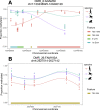Comparative analysis reveals distinctive epigenetic features of the human cerebellum
- PMID: 33956822
- PMCID: PMC8101944
- DOI: 10.1371/journal.pgen.1009506
Comparative analysis reveals distinctive epigenetic features of the human cerebellum
Abstract
Identifying the molecular underpinnings of the neural specializations that underlie human cognitive and behavioral traits has long been of considerable interest. Much research on human-specific changes in gene expression and epigenetic marks has focused on the prefrontal cortex, a brain structure distinguished by its role in executive functions. The cerebellum shows expansion in great apes and is gaining increasing attention for its role in motor skills and cognitive processing, including language. However, relatively few molecular studies of the cerebellum in a comparative evolutionary context have been conducted. Here, we identify human-specific methylation in the lateral cerebellum relative to the dorsolateral prefrontal cortex, in a comparative study with chimpanzees (Pan troglodytes) and rhesus macaques (Macaca mulatta). Specifically, we profiled genome-wide methylation levels in the three species for each of the two brain structures and identified human-specific differentially methylated genomic regions unique to each structure. We further identified which differentially methylated regions (DMRs) overlap likely regulatory elements and determined whether associated genes show corresponding species differences in gene expression. We found greater human-specific methylation in the cerebellum than the dorsolateral prefrontal cortex, with differentially methylated regions overlapping genes involved in several conditions or processes relevant to human neurobiology, including synaptic plasticity, lipid metabolism, neuroinflammation and neurodegeneration, and neurodevelopment, including developmental disorders. Moreover, our results show some overlap with those of previous studies focused on the neocortex, indicating that such results may be common to multiple brain structures. These findings further our understanding of the cerebellum in human brain evolution.
Conflict of interest statement
The authors have declared that no competing interests exist.
Figures




Similar articles
-
Epigenetic ageing of the prefrontal cortex and cerebellum in humans and chimpanzees.Epigenetics. 2022 Dec;17(12):1774-1785. doi: 10.1080/15592294.2022.2080993. Epub 2022 Jun 2. Epigenetics. 2022. PMID: 35603816 Free PMC article.
-
Genome-wide DNA methylation analyses in the brain reveal four differentially methylated regions between humans and non-human primates.BMC Evol Biol. 2012 Aug 16;12:144. doi: 10.1186/1471-2148-12-144. BMC Evol Biol. 2012. PMID: 22899776 Free PMC article.
-
Comparative Methylome Analyses Identify Epigenetic Regulatory Loci of Human Brain Evolution.Mol Biol Evol. 2016 Nov;33(11):2947-2959. doi: 10.1093/molbev/msw176. Epub 2016 Aug 25. Mol Biol Evol. 2016. PMID: 27563052 Free PMC article.
-
Comparative studies of gene regulatory mechanisms.Curr Opin Genet Dev. 2014 Dec;29:68-74. doi: 10.1016/j.gde.2014.08.010. Epub 2014 Sep 16. Curr Opin Genet Dev. 2014. PMID: 25215415 Free PMC article. Review.
-
An integrative understanding of comparative cognition: lessons from human brain evolution.Integr Comp Biol. 2020 Oct 1;60(4):991-1006. doi: 10.1093/icb/icaa109. Integr Comp Biol. 2020. PMID: 32681799 Free PMC article. Review.
Cited by
-
FAM193A is a positive regulator of p53 activity.Cell Rep. 2023 Mar 28;42(3):112230. doi: 10.1016/j.celrep.2023.112230. Epub 2023 Mar 9. Cell Rep. 2023. PMID: 36897777 Free PMC article.
-
Cross-Species Comparative DNA Methylation Reveals Novel Insights into Complex Trait Genetics among Cattle, Sheep, and Goats.Mol Biol Evol. 2024 Feb 1;41(2):msae003. doi: 10.1093/molbev/msae003. Mol Biol Evol. 2024. PMID: 38266195 Free PMC article.
-
Chimpanzee Extraversion scores vary with epigenetic modification of dopamine receptor gene D2 (DRD2) and early rearing conditions.Epigenetics. 2022 Dec;17(12):1701-1714. doi: 10.1080/15592294.2022.2058224. Epub 2022 Mar 28. Epigenetics. 2022. PMID: 35345970 Free PMC article.
-
Epigenetic ageing of the prefrontal cortex and cerebellum in humans and chimpanzees.Epigenetics. 2022 Dec;17(12):1774-1785. doi: 10.1080/15592294.2022.2080993. Epub 2022 Jun 2. Epigenetics. 2022. PMID: 35603816 Free PMC article.
-
Uncovering the genetic profiles underlying the intrinsic organization of the human cerebellum.Mol Psychiatry. 2022 May;27(5):2619-2634. doi: 10.1038/s41380-022-01489-8. Epub 2022 Mar 9. Mol Psychiatry. 2022. PMID: 35264730
References
Publication types
MeSH terms
Substances
Grants and funding
LinkOut - more resources
Full Text Sources
Other Literature Sources
Molecular Biology Databases

